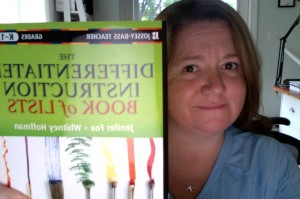The Differentiated Instruction Book of Lists Launches!
After a year of work, our book has been released into the wild!
Differentiated Instruction, in a nutshell, is about delivering a more personalized experience to students in the classroom. It sounds great in theory- wouldn’t we all want to be in a classroom where we feel special, and like the teacher understand us, and we can work as a team to master new skills and knowledge? For many teachers, the philosophy of differentiation gets lost in the day to day application. Teachers think and say things like:
- “I don’t have time to make a separate lesson plan for every kid in my classroom.”
- “I have so many kids each day, I have a hard enough time learning their names, let alone personalizing instruction.”
- “I’d have to change up all my current lesson plans- that would take forever, and I’m not guaranteed this will help.”
- “My current teaching methods seem to be working just fine, thanks. I don’t have time for this.”
The Differentiated Instruction Book of Lists is geared towards making the theory and research supporting differentiation easily doable and achievable in the classroom. I look at it as taking theory from benchtop to bedside in medical research. We may know, in theory, that everything works in experiments, but what’s going to happen “in the wild”? How do I apply this theory and all of these great concepts to my lesson plans and my classroom with my kids, not some theoretical group in a lab school somewhere? The Book is designed with sections for grade levels K-12 and all subject areas. We give ideas, tips and resources to help teachers not only understand DI but how to gradually work it into their classroom, as they are ready.
We’ve also created this website and our Free Bonus Materials and Resources to help create an ongoing community and resource to help you get the support you need as you think about adding DI into your teaching tools.
Reaching Today’s Students
At the ISTE conference in June, I heard Heidi Hayes Jacobs from Curriculum Designers and Curriculum 21 say that daily, students leave a 21st century world to enter a classroom that hasn’t changed substantially since the 1900’s, when education became compulsory in many states. Then they leave this land to re-enter the 21st century at the end of the day, not sure that what they are doing and learning is relevant to their lives. And if we’re honest, we often don’t give kids the reason why learning the chosen curriculum is important, if we even spend time to ask and answer this question for ourselves. The internet has made access to information more ubiquitous than ever before, but we still need knowledge and wisdom more than ever. Making sure education is meaningful and applicable to students is no longer a luxury, but a necessity, and it means a teacher’s role is shifting more to mentor and guide than the sole owner of the knowledge in the classroom.
That said, computers and web-based applications are not, alone, going to transform students and classrooms. Teachers are needed who know when to use these tools and when not to, to make any student’s learning more than it would be otherwise. I tell folks who ask me questions about whether they should have video or audio on their website, that it all depends- are you just telling people something, in which case audio alone might be more powerful, or do they need to see and almost touch what you are saying? In that case, video or other multimedia presentations might be more effective. It takes a good teacher to not only look at the tool, but look at the best and highest use of the tool to make the biggest impact on learning. Our book hopes to help you with some ideas and starters of how to use tech to enhance and differentiate your lessons, but in the end, your actual implication will have the most impact. Teachers are not only being pushed to adopt new technology but to use it in the best way for maximum impact at the same time, as an article in the New York Times seems to implicate. Just having technology is not enough- and we hope the ideas and sample lessons we give in our book help teachers make those small changes to increase the impact of their application.
We hope you find the book useful, and would love to hear your questions, comments, criticisms and more here! Please feel free to comment or to send us email at whitney@differentiatedinstruction.co.






